East Portland residents have a lot of transportation needs. But one of the most comprehensive surveys ever of its residents just found that one rises clearly above the rest.
It’s walking.
A mail-in survey of 1,365 households from east of 82nd Avenue, completed last spring as part of the city’s East Portland in Motion plan, went into depth on many transportation issues, but the theme of walking came up again and again.
Here are the most interesting notes we saw in a writeup (PDF) and presentation this month from David Hampsten, an East Portland neighborhood advocate who also sits on the City of Portland’s Bicycle Advisory Committee. Hampsten helped manage and analyze this massive survey, which was distributed online and as an insert to 60,000 households in East Portland’s city-sponsored newsletter.
Sidewalk projects are the highest priority, residents say
“What 3 kinds of projects are most needed in your community?” the survey asked. One item was far and away the most popular: sidewalks on busy streets, chosen by almost half of respondents.
A distant second: sidewalks on residential streets. Only then did “paving maintenance” come up, with just over one third of East Portlanders putting that one of the top three priorities for their area.
Close watchers of city politics will recall that the Portland Business Alliance has opposed any city street funding package that doesn’t dedicate the large majority of its revenue to maintenance.
Most East Portlanders didn’t rate bike improvements as top priorities. It’s interesting, though, that East Portlanders were at least three times likelier to rate one or both of these among their top three priorities as they were to use a bicycle as their main transportation.
A surprising number of people said they get around mostly by walking
Every year, the city sends a mail survey to a random sample of East Portlanders and asks, among many other things, what mode of transportation they used most over the previous week. For East Portland, only about 2 percent usually choose walking.
But for this survey, which asked “when you go somewhere, what is your main means of travel,” many more respondents — 7 — said they walked. That’s about the same as the number who say that citywide.
Biking, meanwhile, was the primary transportation mode for 4 percent, public transit for 13 percent, and driving for 76 percent. Another 6 percent identified multiple modes as their “main” one.
The result seemed to surprise Hampsten, too.
Crosswalks are a problem almost everywhere east of 205
As thoughtful planners will tell you, improving foot transportation is as much or more about crosswalks as about sidewalks. And sadly, it’s maybe easier to identify the East Portland streets that don’t seem to have major crossing problems than the ones that do.
The high performers here are Burnside (which only has two traffic lanes and two bike lanes in most of East Portland, thanks to the Blue Line MAX down the middle) and, perhaps surprisingly, Glisan and Stark east of 122nd Avenue.
Several major sidewalks still need improvements
Hampsten said the city has made serious progress in improving sidewalks on major streets in recent years, though many residential streets still go without. But there are a few that many people agree need work.
Though the map above tries to convey maybe too much information, it’s a good visualization of the streets that people were most likely to say need sidewalks: outer Powell, which is actually operated by the Oregon Department of Transportation, and the Market-Mill-Millmain-Main corridor, which is designated to become an important neighborhood greenway but is awaiting city funding.
Halsey east of 122nd, Harold west of 136th and Division west of 148th were also popular picks for streets that need better sidewalks.
Advertisement
One in four households include someone who gets around by bike
The question was “how many people in your household ride a bike for transportation. Of 1,365 survey takers, there were a total of 558 transportation bikers in 28 percent of the households.
Keep in mind that this question asked about transportation, so (to the extent that people were reading carefully) it doesn’t capture people who ride only for fun and exercise. That’s a number that is typically larger than transportation bikers.
The worst concentration of biking hotspots is in Hazelwood
Survey takers were asked to name East Portland’s worst bike connections.
The Halsey-Glisan-Burnside business district just east of I-205 seems to have gotten the most complaints, with a clear string of problems running down outer Division and, to a slightly lesser extent, outer Powell.
East Portland has a very long way to go, but it’s making progress
Though it’s hard to argue with the fact that East Portland is in more dire need of transportation investment than any other part of Portland, it’s also hard to deny that East Portlanders have been fairly successful at organizing around those needs and getting results. The very existence of this survey, and of the entire city-funded East Portland in Motion plan, is part of the area’s recent success.
The rest of the city should be helping East Portland solve its problems. But it should also be learning from Hampsten and other advocates who’ve learned how to coordinate their messages and, ultimately, start getting things they need.


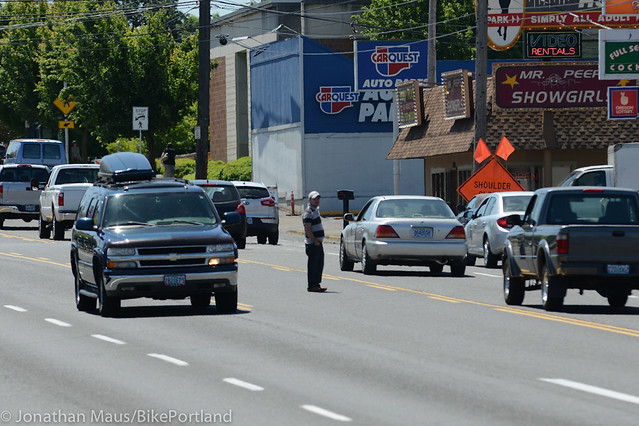
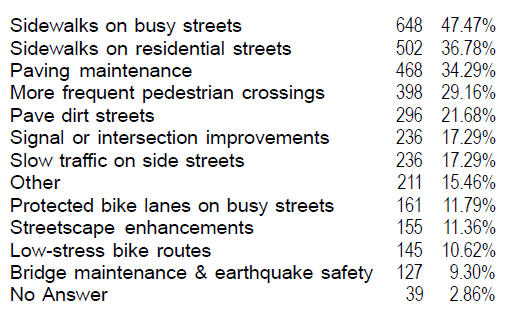

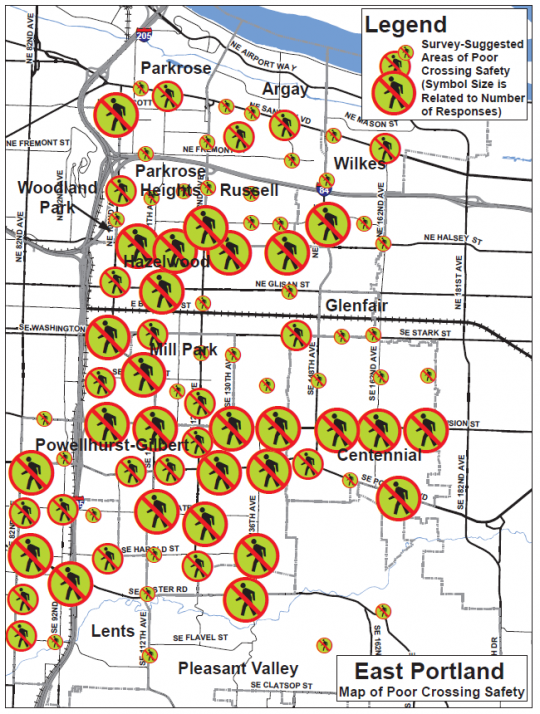
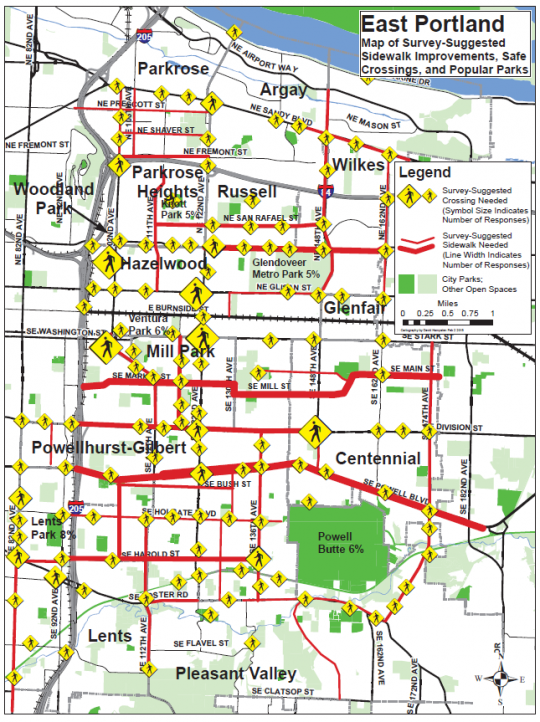
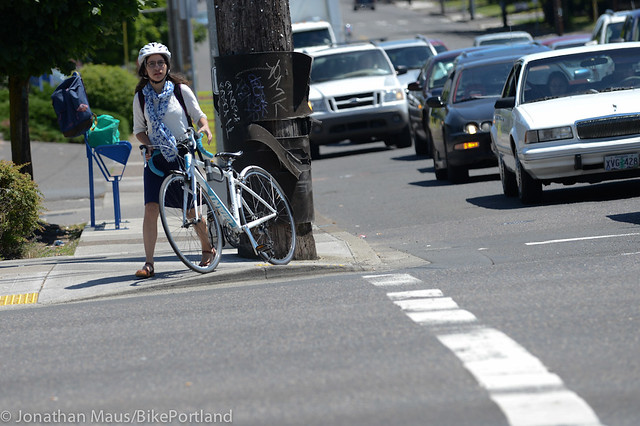
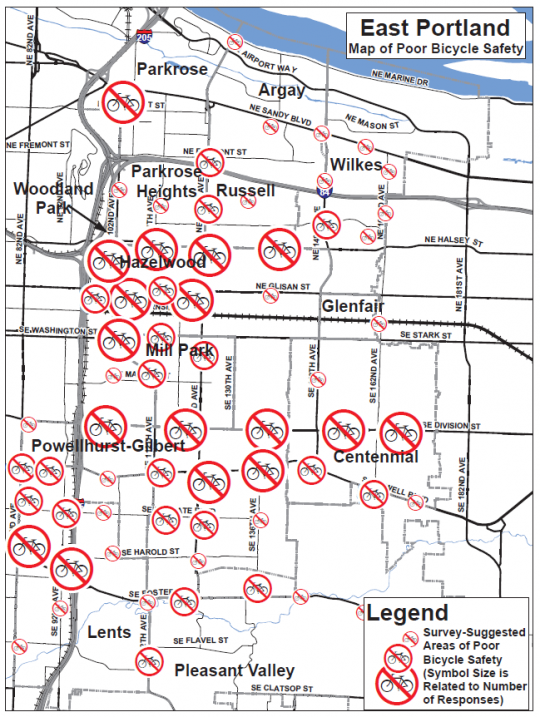
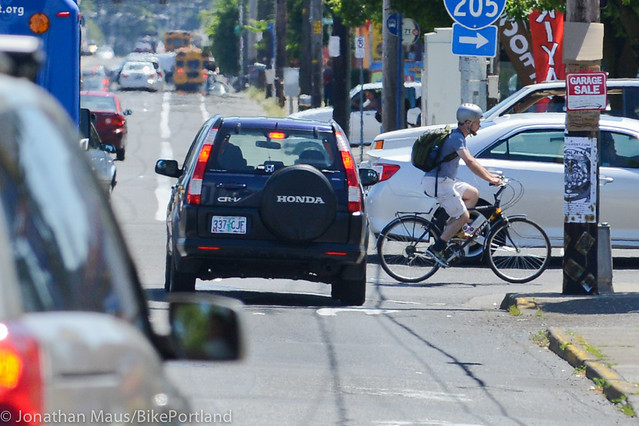
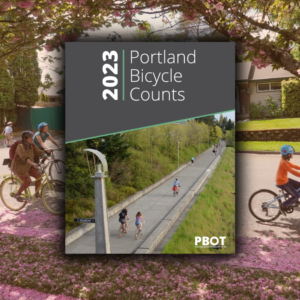
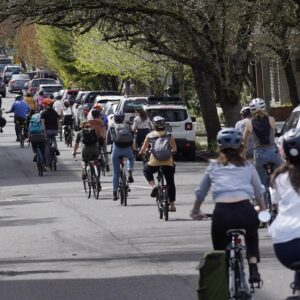
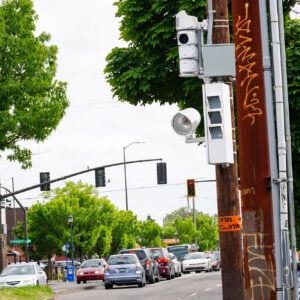

Thanks for reading.
BikePortland has served this community with independent community journalism since 2005. We rely on subscriptions from readers like you to survive. Your financial support is vital in keeping this valuable resource alive and well.
Please subscribe today to strengthen and expand our work.
I’ve been wondering why the city is spending $$ re-doing all the sidewalk intersections in the inner city when they could use the money to build sidewalks on this end of town.
Do you have examples of such? Don’t forget the last mayor added all those sidewalks on Stark, 162nd, and Division.
I’m guessing sidewalks on Powell is an ODOT issue?
And outside of arterials there are few east Portland residential streets that even have a sidewalk on one side, including many that are next to parks and schools.
You are right and it has improved the last few years, but it’s improving at a pretty slow rate. They have a lot of catching up to do.
You understand that sidewalks on local streets have been traditionally been built by local residents, primarily via the developer of the land? Are you expecting the taxpayers to now fund east county sidewalks on local streets?
Sidewalks on local streets have generally been required of the builder by the City or County. Just because the local authority made a bad decision X number of years ago and exempted a builder (or resident) from a requirement at time of development, doesn’t make the current residents and/or owners responsible for the resulting lack of safety resulting from this omission. That responsibility lies with the original authority or its successor: the City of Portland. No matter how hard PBOT would like everyone to think the contrary (which is understandable and in PBOT’s interest as an agency with constrained funding, but still wrong).
If you’re referring to all the ADA curb ramps, those are required by federal law whenever the city repaves a street or constructs new traffic signals. It’s not like they could just spend that money on something else.
I”ve seen some of them going in around North Tabor and Laurelhurst though without any other noticeable street improvements. They’re on very residential intersections.
Also the ADA program.
You work for PBOT. I’m not remotely surprised that you’re going to toe the company line.
I believe the WW article, even if they don’t have a perfect source. The city has used this “myth” to just wash their hands of having to actually do anything, meanwhile funneling most of East Portland’s tax dollars to inner neighborhoods. The city could also easily change the “agreement” of not maintaining unimproved streets. (unimproved streets are maintained in plenty of areas around the US) Given the issue Portland has with unimproved streets this would be a pretty good compromise given the lack of action there has been in LIDS or “smart streets” (which is still very expensive for homeowners).
Instead of just throwing their hands up and continuing the status quo, which clearly hasn’t really been working for decades. Maybe PBOT needs to revaluate their policies and not just wait and hope for private developers to do everything for them.
sorry this was nested incorrectly.
I NEVER see the city repaving streets anymore, just filling potholes, but see Them adding the ADA curb ramps at every intersection throughout town which make it hard for school buses, etc. to make turns because of these. Lighted crosswalks would make it safer and save lives.
One suggestion at the recent lunch and learn was that many of the people driving also wanted better pedestrian and bike facilities so they would feel safer driving.
It’s been demonstrated that improving safety for pedestrians and cyclists will also improve safety for people driving.
The third photo is great. center lane (?), two travel lanes, bike lane and empty parking lane. Seems like a bike lane next to the curb, and converting that bike lane to a buffer or island, with pro-time parking on the outer travel lane would do much to make such corridors in east Portland very nice multi-modal facilities.
One nice thing about streets that are too wide – lots of room to build protected bike lanes!
Clearly, paving “unimproved” streets and repaving streets that are in disrepair are far less important than City Hall seems to think they are.
That’s a really complicated issue.
My neighborhood has a lot of unpaved street (we’re second most in the city).
There are some people that like them (seems to be more of these folks around Woodstock), think they are “quaint” and prevent traffic and crime.
There are many who have frustratedly just given up on the city ever doing anything about them. Or assume that they will have to pay a large amount of money (that most don’t have in these areas) themselves. A lot of people in this area of town are pretty disillusioned with anything the city promises or actually does.
Same thing with sidewalks.
It should also be pointed out that only 4 of the top 12 neighborhoods for unpaved streets are actually in this survey’s reach in East Portland anyway (granted the top one is, but also only #5, 9, and 11)
http://www.wweek.com/portland/imgs/media.images/4413/lede_3727_(map).jpg
And paving dirt roads did poll twice as much as protected bike lanes.
There is also the fact that this survey had a 2.3% response rate. So I’d take most of it with a grain of salt.
Personally, I have mixed emotions on the unpaved or unimproved roads.
They are great traffic diverters, what little auto traffic they get tends to be pretty slow and cautious, and as long as you’re riding an appropriate bike (ie no carbon bits), great to ride on.
My neighborhood (South Tabor between Division and Powell for those that don’t know) has quite a few. I can only imagine how much more cut through traffic we’d get if all the roads were paved.
I wouldn’t have as much issue with them if they were just maintained, instead many turn into crater filled moonscapes that are impassable for good chunks of the winter. It wouldn’t cost PBOT a ton to just use a grater and run a little gravel on them. Smooth them out decently and make them passable for pedestrians cyclists and cars year round.
And in most of these neighborhoods this is “infrastructure” that Portland inherited when they forcibly annexed these areas. Prior to that I’m told by locals that the county actually did maintain many (or at least some) of these streets.
Again, you do understand that traditionally local streets have been the responsibility of local land owners, usually via the land developer? Are you now expecting that all of Portland’s taxpayers begin paying to build local streets?
As for maintenance, the traditional agreement is that Portland taxpayers would assume maintenance responsibility once the road was improved to city standards.
http://www.portlandoregon.gov/transportation/article/146099
http://www.portlandoregon.gov/transportation/article/417045
http://www.portlandoregon.gov/transportation/58466
I’m happy to “maintain” the 1/4 block of unimproved roadway at 86th ct and Holgate – just as long as we can also restrict the traffic on it to use by only members of the three households that are paying for the maintenance. Otherwise – the city should pony up if they want to continue to allow 4-5 vehicles (including large trucks, garbage service etc) per hour to use the street.
If it’s handling city traffic, it’s a city street and should be maintained by the city.
Traditionally?? When? IN the early 1900s? Sheesh…
Oh, I just bought a house in South Tabor!
Welcome to the neighborhood (one of Portland’s best kept secrets-though not for long I suspect.)
“Or assume that they will have to pay a large amount of money (that most don’t have in these areas) themselves”
Agree.
And or realize that when the streets are paved; property values are going up, taxes are going up, demand is going up and rents are going to go up…followed in short order by the demolitions, and the $400K dollar houses.
Gentrification is coming; as soon as the general taxpayer agrees (is conned in) to paving those streets, the developers will arrive like a flock of gannets.
They’re coming anyway.
I agree about the perception of unpaved streets is not categorically bad in East Portland. Heck for some this is an off-road cycling opportunity!:)
The same could be said about the lack of sidewalks in East Portland, an issue that is not as straight forward as some in the media portray. There are clearly areas where sidewalks are critically needed for safety. However there are also low traffic streets where residents do not desire sidewalks in part because their absence can actually help calm traffic. I have also seen new sidewalks come into conflict with tree preservation…. and Portlanders love their trees.
East Portland has a unique urban form and community and the solutions to problems have to be appropriate to East Portland. There are also unique opportunities for innovation in East Portland that don’t exist in other parts of the City.
Equity is not about having things exactly the same. It is about having equitable levels of investment and an equitable voice in how that investment happens in neighborhoods. This is something the City and the Media needs to keep in mind.
“East Portland has a unique urban form and community and the solutions to problems have to be appropriate to East Portland.”
Fair points, but PARTS of East Portland have a unique urban form and community.
Just as you say for everywhere else. one size does not fit all.
I’d imagine a better 205 path connection through Hazelwood/Mill Park would do wonders to that problem.
It’s sooo screwed up through there.
And though not often one to be in favor of cycle track (it has it’s place just not everywhere) one on Division from 82nd (west bound could easily be extended to 60th or 52nd) out would likely work pretty well. There is plenty of room and hardly any roadside parking (where available) is used. And other than a few commercial sections lots of spaces between driveways and road intersections.
Perhaps not coincidentally, those East Portland major streets are also places where people die.
https://www.portlandoregon.gov/transportation/article/524195
“Pedestrians bore the brunt of the traffic fatalities in 2014. Nationally, pedestrians make up 14% of all traffic fatalities. In Portland, over the past five years, they have made up a third of fatalities, more than double the national average. In 2014, of the 28 total traffic fatalities, over half (15) were pedestrians.”
75% of East Portland residents use cars as a primary means of transport.
Putting that fact together with the remarks following Ms. Looman’s interesting piece re; car-shaming: we need to have some sort of public shaming of East Portland, right? Maybe a lot of inner-SE Cyclists can go to Lents and hold signs shaming drivers!
75% is close to the Portland average.
I’m hoping the Powell / Division project will fix outer Division and have lots of crossings for peds and bikes.
So nobody is going to point out the fact that the guy in the lead photo is like 30 yards away from a crosswalk sign?
Telephoto images, such as the one shown, distort distances due to the narrow field of view, which has the effect of compressing the background. I’m betting it’s more like 100yards+
The picture is on SE 122nd ave, near SE morrison. It’s a midblock crossing for the library, no signal or warning lights, at least as of Oct ’14 streetview. It’s 300 feet from the crosswalk to the Showgirl building. He’s standing past there. Just before the shared middle turn lane becomes a turning lane for northbound traffic only. That’s about 600 feet from the crosswalk.
122nd south of Morrison has rapid flash beacons.
Yes you’re right. Not sure why I missed that.
Biking up SE 136th today, it was nice to see the whole section between Powell and Division was getting some new sidewalks. I think these wide sidewalks will go a long way towards making it more safe for all kinds of people to use the road.
Ruthie,
Did you notice they striped a bike lane? This project created space for a northbound bike lane from foster to division, but PBOT is reluctant to stripe bc the southbound bike lane is discontinuous. In the meantime, the road just got really wide and really fast!
I’d like to see an island at 136th and the Springwater.
Why 136th & Springwater? 136th is only two lanes and about 24 feet across. More often than not, motorists wave me across.
Placing an island there would essentially be telling motorists that cyclists are intended to stop in the middle and that the motorists need not stop until the bicyclist or pedestrian gets to the island. Besides that, making the island big enough to shelter a cargo bike, bike with trailer, or tandem would make for a really expensive project. There are many places I’d rather see islands than this location.
Didn’t that intersection just get a rapid flash crossing too?
Median islands benefit more than cyclists. Median islands permit pedestrians to concentrate on one direction of traffic at a time. This benefits our youngest and oldest pedestrians the most. Refuge islands permit users to string together two shorter and different gaps in traffic instead of finding two opposing overlapping gaps. This increases the number of crossing opportunities. Lastly, in every respect, traffic on the other side of a refuge island does not have to stop for a pedestrian until they reach the island, so refuge islands on busier streets can reduce delay to people driving.
I don’t quite understand this sentence .. 7 is many more ?
==>> But for this survey, which asked “when you go somewhere, what is your main means of travel,” many more respondents — 7 — said they walked. That’s about the same as the number who say that citywide.
7%. Many more (in relative terms) than the 2% that made a similar statement in the other survey discussed in the prior paragraph.
7% not 7 actual respondents
And that’s a lot more than the 2% the city got with their survey.
If the pedestrian infrastructure isn’t there, what good are bike lanes? A bicyclist with a flat tire will soon become a pedestrian.
SW Portland is in desperate need of bike and pedestrian improvements, OHSU is the largest employer in the Portland area, PCC has their largest campus in SW, the soil and watershed is in desperate need of overhauls and the soil is more like clay than the east side.
How do you overhaul the soil?
Sidewalks and paving of residential streets show high on the list, but respondents didn’t indicate who should pay for these improvements. The properties on Portland’s unpaved roads and streets without sidewalks paid less for their property and are paying less in property tax because they don’t have these features. They also can add these features if they are willing to pay for them through the PID process.
If residential streets are not paved or have sidewalks it is the adjacent property owners responsibility not the City’s.
http://www.wweek.com/portland/article-17460-dirt_roads_dead_ends.html
“In a 2000 report to City Council about funding for street improvements, an expert panel delved into the history of Portland infrastructure. They called the notion that property owners have always borne the cost of paving streets a “long-standing myth.”
As recently as 2000, the study found, the city was paying most or all of the costs to pave many streets, especially in poorer neighborhoods.
“The implication of this myth was that property owners paid almost entirely for their street, a proposition that is nowhere near the truth,” the report says. “It is much more accurate, and also much more relevant to the problems we face today, to state that property owners have almost always helped pay for at least a portion of the costs for improving their streets.”
It’s questionable as to whether they got their property cheaper because of no sidewalks. A much stronger factor is the location of the property.
And no they don’t get reduced tax rates because of it. In fact many of them pay a higher percentage of tax rates than much of the city.
http://www.opb.org/news/article/new-study-highlights-inequity-in-oregon-property-taxes/
The scary thing is most folks in these areas are paying MORE in percentage of taxes and getting LESS city resources.
Longstanding myth? Maybe you should check who paid for the paving your residential street, then check other streets and find out who paid and how the right of way was acquired in the first place. Sometimes development fees and PID taxes used for public improvements may look like a tax and be reported as if public dollars are used, but they are a direct fee for service.
Property, corporate, and sales taxes are all regressive. For example, if you rent, you pay the property tax and someone else gets to deduct it. But this doesn’t have anything to do with developments that did not include sidewalks.
Dave,
I checked out the WW article. It provides no citations or references. Local Improvement Districts are financed by the City, so if you want to say they are funded without any supporting documentation, fine, but that financing is paid back to the City by a long-term assessment on the properties fronting the improvement. Many of the large roads have been developed over time using private and public funds. The same cannot be said for local service streets.
http://www.portlandoregon.gov/transportation/article/500905
LIDs are incredibly impractical in these areas. There are a number of reasons that that have had very minimal use in Portland, with the main one being a high price to mostly lower income areas.
I have tried to get the sources, by my emails to WW have gone unanswered. I guess I could try get transcripts of that report to council, but I am not all that optimistic that the city would release that, given that they have been saying the opposite for years.
If only we knew someone at PBOT that might have access to that report……..
Also in my experience, few at PBOT have seen that WW article, which is a little surprising to me.
And just wait until they find out that they are responsible for maintaining and repairing any damage that occurs to the sidewalks in front of their homes.
D,
One of the reasons the last mayor initiated the street by street initiative was to lower the cost of LID project, particularly for underserved areas.
http://www.portlandoregon.gov/transportation/58466
I am unaware of any such reports and nothing comes up on a web search.
A more specific date of the report fifteen years ago would be helpful.
I emailed the author, he was nice enough to send me the cover page. Knowing what to look for, I was able to find it online.
ftp://ftp02.portlandoregon.gov/PBOT/LID_Program/Council_Report_20001101/
An excerpt from one section you might find relevant
ftp://ftp02.portlandoregon.gov/PBOT/LID_Program/Council_Report_20001101/Section%202.0%20-%20Hist%20of%20Local%20Infr%20Imp%20in%20Portland%20-%20pg%205-8.PDF
“Even though the participation of property owners in the funding of street improvements has remained constant over time, the amount that property owners have paid to improve streets has varied. Even within the first 20 years of the City, there was not a consistent percentage that property owners paid as their share fell from two thirds to one half of the cost….
…
Even today, there is a wide range in what property owners pay for street improvements. In some areas of the City, little to no public funding is available to assist property owners with the cost of improvements. In other areas, most notably low income neighborhoods, the City may pay 70% to 100% of the improvement costs.
…
…long-standing myth among citizens and government officials alike – that all of Portland’s local streets were paid for by the abutting property owners.”
Perfect Ted. Thanks so much for that. I’ve been trying to track it down for a while (I didn’t see the author worked at WW when I was emailing them).
“During the Depression in the 1930’s, the federal government stepped in and im-proved streets through the Works Progress Administration (WPA). The WPA was essentially a jobs program that focused on public works projects as a means for providing employment. As in some Portland neighborhoods today, many streets in the City were paid for at or near a 100% level by the federal government, while at the same time other street improvements were being made in the City where property owners or developers were covering the costs of the projects.”
Ted, do you have a good way to read this? The top link takes me to a directory and when I click on one of the files, I just get a scrambled mess.
The ones I looked at opened fine for me. Maybe try a different pdf reader?
D,
Didn’t Oregon’s taxpayers vote in the real estate tax system that is currently in place?
Yes. Regardless, it is really screwed up (and even city council and city government recognize this). https://www.portlandoregon.gov/novick/article/428020
http://www.oregonlive.com/politics/index.ssf/2014/03/study_oregons_weird_property_t.html
Just because something was voter approved 20 years ago doesn’t mean that it hasn’t had major negative impacts on our city (and state) and shouldn’t be reevaluated.
Except when the elected and hired government proposes altering the tax system to increase revenue they are attacked from almost every front. A revised tax system that does not originate from the public is as unlikely to succeed as it is unlikely to happen. Doing more with less only gets you so far and then you simply have to do less.
Which is interesting because I think Portland likes to think of its self as a bit of a “we’re okay with taxes” kind of city (see the recent Arts Tax). Granted this is a state law and not Portland-specific.
LID?
http://www.portlandoregon.gov/transportation/article/82647
Due to a wrinkle in the property tax rules, someone with a 400k house in Lents pays more property tax than someone with a 400k property closer in. East Portland is owed reparations, IMHO. The tax arguments are complex. I see your point re: residents not paying, but we can’t look it at in isolation. Had the city not density dumped and let the developers skate on improvements, East Portlanders wouldn’t have such a mess to clean up.
That’s the biggest issue, how do we fix this?
Just waiting around for these neighborhoods to self finance improvements is just not going to happen (remember these are mostly the lower income areas of the city).
So instead the issue just gets kicked down the can for decades.
Don’t all of the new developments in east Portland require new sidewalks to be built? I thought it was all of the housing built before annexation that was the problem…
If the rest of the street doesn’t have sidewalks, developers often petition to get out of the sidewalk requirement and it’s frequently allowed.
Cora is right we’re seeing a lot of exemptions these days.
That is crazy. They definitely need to fix that loophole.
Talk to our development-happy mayor…….
does the News Editor need his own editor ?
Incidentally…people living out on the westside in Beaverton, may be interested in reading a story posted today on oregonlive, about determining the need for and number of school bus stops.
http://www.oregonlive.com/beaverton/index.ssf/2015/04/walking_to_school_1000_more_be.html
Areas around a bunch of schools are affected. At least some I know of, have sidewalks to the schools, but the safety of actually walking them, is debatable, given levels of vehicle traffic that’s occurred as result of development. District officials studied routes to schools, and decided some were sufficiently safe enough for kids to walk, that some of the stops could be eliminated, saving money. Parents disagree.
Walking is the most fundamental, basic, enjoyable and safe mode of transportation people can travel by, if when designing new development, conditions enabling safe, enjoyable walking are deliberately designed into the development concept.
the guy in first pic ..crossing 122nd is not much awake. there is a signalized crossing about 100 feet away , at the library crossing.
550-600 feet to the library crossing. ~250 feet to the light at SE stark. He’s standing where the left turn lane onto SE stark begins, right by the bus stop. Bus stops should always be next to pedestrians crossings. People try to cross the street there anyway.
I think pedestrian crossings should be moved 20ft. before or after bus stops because oncoming traffic has a hard time knowing if someone is trying to cross the street or simply waiting for the bus.
ummm, Ted …. you can see the Northern corner of the library in the photo (and the signs showing where to stop) . crossing is about 30 feet further. No need to get stuck in the middle of 122 when a signalized crossing is so close.
@SW
http://en.wikipedia.org/wiki/Perspective_distortion_%28photography%29
Look at the area on google maps. It’s more than three hundred feet from the crosswalk to the showgirl building. He’s standing past there, where the turn lane begins. The crosswalk the other way is much closer.